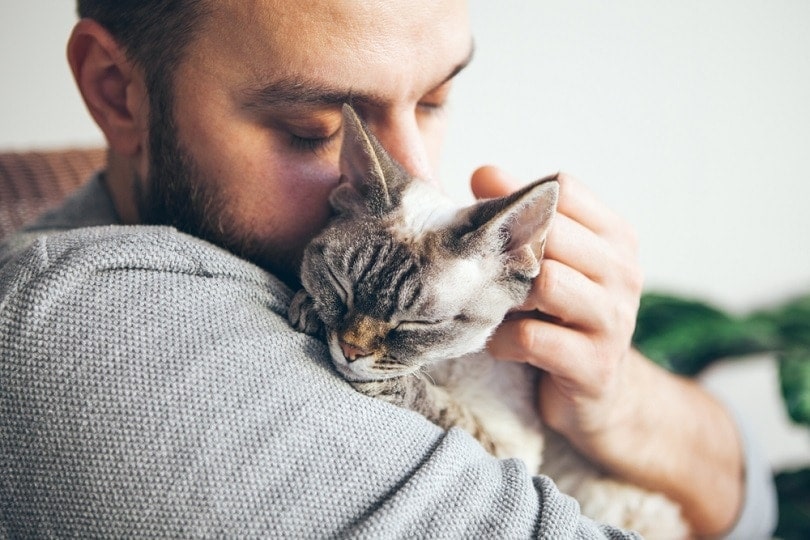Cats are often seen as independent and aloof creatures, but if you’ve ever wondered about the depth of their loyalty, you’re in for a delightful surprise. While they may not have the same overt protective instincts as dogs, many cats exhibit subtle, instinctual behaviors that indicate they are looking out for their human companions. Understanding these signs not only deepens the bond you share with your feline friend but also enriches your appreciation for their unique personalities.
In this article, we’ll explore the various ways your cat may be silently guarding you, from vigilant watchfulness to peculiar behaviors that suggest they sense something amiss. So, let’s delve into the intriguing world of cat behavior and uncover the heartwarming ways your furry companion shows their love and protection.
Table of Contents
- Understanding Feline Instincts in a Protective Role
- Body Language Cues: How Your Cat Communicates Safety
- Vocalizations and Sounds: The Hidden Messages of Your Cat
- Creating a Safe Space: Enhancing Your Cats Protective Behavior
- Q&A
- The Conclusion
Understanding Feline Instincts in a Protective Role
Felines possess a range of instinctual behaviors that often manifest when they feel a need to protect their human companions. Cats are naturally territorial and have a keen awareness of their surroundings, which makes them sensitive to changes in their environment. When they perceive a potential threat, you might notice your cat exhibiting certain behaviors that signal their protective instincts. This could include vocalizations, such as growling or hissing, when someone unfamiliar approaches, or they might position themselves between you and the perceived threat, ready to defend their territory. Additionally, if your cat frequently inspects areas of your home or follows you closely, it’s a sign they’re vigilant and on guard, ensuring your safety.
Body language also plays a crucial role in how cats express their protective instincts. Indicators such as alert ears, a puffed-up tail, or a stiffened posture can suggest that your furry friend is on high alert. In some cases, they may even engage in playful behaviors that mimic hunting, showcasing both their stealth and readiness to spring into action if necessary. Here are some subtle yet telling signs of a protective cat:
- Increased grooming: This can indicate stress but may also be an attempt to comfort you.
- Bringing you “gifts”: Offering toys, or even prey, can be a form of showing care and protection.
- Following you everywhere: A cat that shadows your movements is likely keeping a close eye on you.
Body Language Cues: How Your Cat Communicates Safety
Cats have a unique way of expressing their emotions and intentions, especially when it comes to protecting their humans. Understanding your feline friend’s body language is crucial for reading the signs that indicate they feel safe and secure in their environment. Here are some common cues to look for:
- Slow Blinking: When your cat gazes at you and slowly closes their eyes, it’s a sign of trust and affection. This behavior suggests they feel safe around you.
- Purring: A contented purr is often associated with a relaxed state. If your cat is purring while curled up next to you, they are likely feeling secure.
- Tail Position: A high-held tail usually indicates a happy and confident cat. If their tail is quivering, they might be expressing excitement and affection.
- Body Posture: A cat that lies on its back with its stomach exposed is showing vulnerability, which signifies trust. It believes you will protect them.
To further understand your cat’s protective behavior, it’s helpful to observe how they interact with their surroundings, as well as how they respond to potential threats. The following table summarizes key body language cues that indicate your cat feels safe while on guard:
| Body Language Cue | Meaning |
|---|---|
| Flicking Ears | Alertness to sounds around them, indicating they are on watch. |
| Forward-facing Whiskers | Curiosity and readiness to confront or investigate. |
| Crouched Position | A sign of awareness, preparing to react to any threat. |
| Frequent Grooming | Self-soothing behavior when feeling stressed but reassured by your presence. |
Vocalizations and Sounds: The Hidden Messages of Your Cat
When it comes to feline communication, cats are masters of vocalization, using a variety of sounds to convey their feelings and intentions. From soft purring to sharp hissing, each sound carries its own significance that can help you understand whether your cat is feeling threatened or protective. Trilling, for example, often indicates excitement or a desire for attention, while a low growl can serve as a warning for perceived threats. Moreover, a cat’s meowing can range from affectionate to urgent, depending on the context. Paying close attention to these vocal nuances can give you insight into your cat’s role as a protector, alerting you to potential dangers in the environment.
Furthermore, the context in which these sounds occur plays a crucial role in understanding their meanings. Observing your cat’s body language in conjunction with vocalizations can paint a clearer picture of their emotional state. For instance, if your cat is hissing while standing tall with arched back, this indicates a defensive posture and a readiness to protect you. In contrast, if your cat emits a series of chirps while watching you from a distance, they may be signaling their vigilance against external threats. Here’s a quick reference table to illustrate some common cat sounds and their potential meanings:
| Sound | Possible Meaning |
|---|---|
| Purring | Contentment and relaxation |
| Hissing | Fear or aggression |
| Growling | Warning or defense |
| Chirping | Alertness, often indicating a threat |
Creating a Safe Space: Enhancing Your Cats Protective Behavior
Creating a safe environment for your feline friend can significantly enhance their protective instincts. Cats are naturally attuned to their surroundings, and when they feel secure in their space, they are more likely to exhibit behaviors that indicate they are looking out for you. One effective way to foster this sense of safety is by providing cozy, designated areas for your cat to retreat to when they feel the need. Consider incorporating elements such as a covered cat bed or a quiet corner of the house, adorned with familiar scents and textures, where your cat can observe their territory. This setup not only boosts their confidence but also encourages protective behavior as they become the self-appointed guardians of their sanctuary.
Additionally, engaging your cat in interactive play can help strengthen their protective bond with you. Activities like feather wand play or laser pointer chases not only stimulate their mind but also tap into their instincts to track and protect their human companions. Make sure to create a routine that offers structured playtime, allowing them to express their natural hunting tendencies while remaining vigilant. Establishing a reward system for when your cat shows protective behaviors, such as alerting you to noises or staying close during stressful situations, can further reinforce their role as your furry guardian. By nurturing a safe space and encouraging protective interactions, you empower your cat to assume their role as an integral part of your safety team.
Q&A
Q&A:
Q: How can I tell if my cat is protecting me?
A: Cats have unique ways of showing their affection and protective instincts. Look for signs like following you around the house, sitting near you, or positioning themselves between you and an unfamiliar person or loud noise. These behaviors indicate that your cat feels a sense of responsibility for your safety.
Q: Do all cats display protective behaviors?
A: Not all cats display protective behaviors in the same way. Some may be naturally more protective due to their personality, while others may show these instincts less frequently. Factors such as breed, socialization, and individual temperament play a significant role in a cat’s protective behavior.
Q: What physical signs might indicate my cat is on “guard duty”?
A: When your cat is in protective mode, you might notice a few physical cues. Their ears may be perked up and facing forward, their body posture may be tense or alert, and they might have their tail held high or puffed up in response to perceived threats. These clues suggest they are on high alert.
Q: Can a cat sense when I’m upset or stressed?
A: Yes! Cats are highly attuned to their human’s emotions. They can pick up on subtle changes in body language, voice tone, and scent when you’re feeling anxious or upset. In response, they may choose to stay close to you or engage in comforting behaviors, such as purring or kneading.
Q: What should I do if I notice my cat acting protective?
A: If you notice your cat acting protective, it’s important to acknowledge their behavior without reinforcing fear. Reassure your cat with gentle words and petting. Pay attention to the situation that triggers their protective response and try to create a calm environment where they feel safe.
Q: Are certain breeds more protective than others?
A: Yes, some cat breeds are known for their protective tendencies. Breeds like the Maine Coon, Siamese, and Ragdoll often form strong bonds with their owners and may exhibit more protective behaviors. However, individual personality is the most significant factor.
Q: Is it possible for a cat’s protective behavior to become excessive?
A: Yes, while a certain level of protectiveness is normal, excessive guarding can indicate anxiety or stress. If your cat is overly aggressive towards visitors or becomes distressed in everyday situations, it’s best to consult with a veterinarian or a feline behaviorist for guidance.
Q: How can I encourage my cat’s protective instincts?
A: Building a strong bond with your cat can naturally encourage their protective instincts. Spend quality time together, provide a safe and enriching environment, and engage in activities that promote trust, such as interactive play or grooming. This helps create a sense of security for both you and your furry friend.
Q: Are there any risks associated with a protective cat?
A: While it can be endearing, a protective cat may sometimes display aggression, especially if they perceive a threat. It’s crucial to recognize their boundaries and ensure that they feel secure. Monitoring their behavior and providing positive reinforcement can help to mitigate any risks.
Q: What is the best way to show appreciation for my cat’s protective nature?
A: Show your appreciation by providing lots of love and attention! Positive reinforcement through treats, playtime, and petting can help strengthen your bond. Recognizing their protective behaviors and celebrating those moments can also reinforce their instincts and make them feel valued.
By understanding these subtle signs, you can deepen your bond with your feline friend while also appreciating their unique ability to protect you!
The Conclusion
recognizing the subtle signs that your cat is protecting you can deepen your bond and enhance your appreciation for your feline companion. Whether it’s their vigilant watchfulness, affectionate presence, or those moments of playful alertness, each behavior speaks volumes about their instinctive desire to keep you safe. By tuning into these cues, you not only gain insight into your cat’s personality but also foster a relationship built on mutual understanding and trust. So, the next time you catch your kitty in a protective stance or hear them give a cautious meow, remember that these gestures, though often understated, reflect a love that runs deep. Cherish these moments, and embrace the unique ways your cat shows their loyalty. After all, in this wonderful partnership, you both look out for each other!















